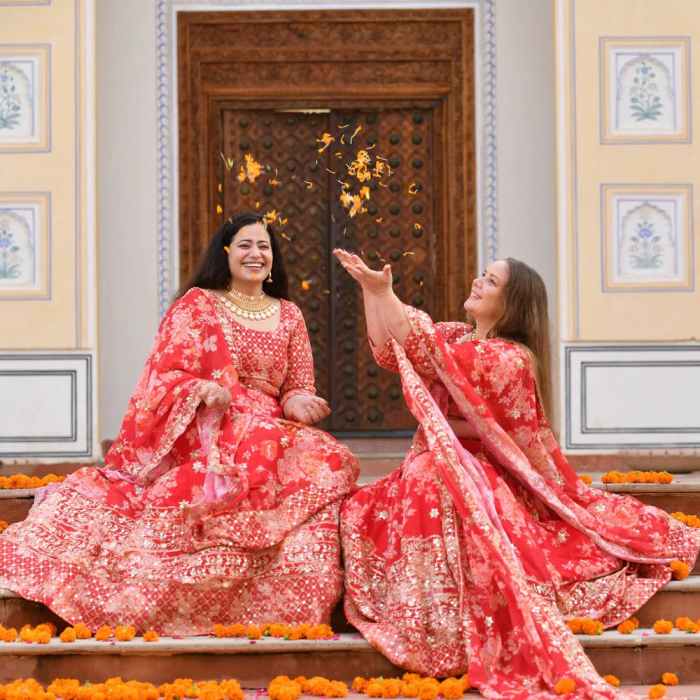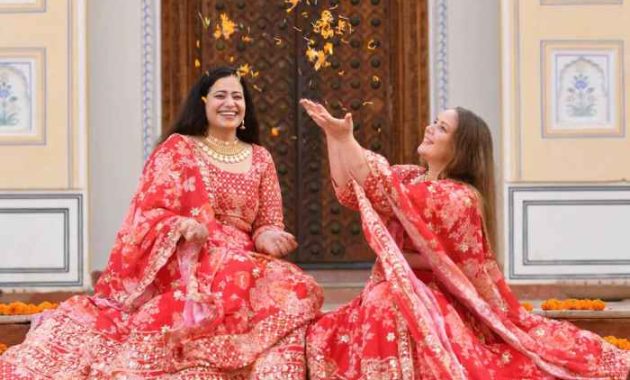Indian Bridal Attire: A Tapestry of Tradition and Modernity: Bride Dress In Indian Wedding

Source: lbb.in
Bride dress in indian wedding – Indian weddings are renowned for their vibrant celebrations and the breathtaking beauty of the bride’s attire. The bridal ensemble is more than just clothing; it’s a reflection of cultural heritage, regional identity, and personal style. This exploration delves into the diverse world of Indian bridal dresses, examining the styles, colors, jewelry, and evolution of this captivating fashion.
Types of Indian Bride Dresses
Indian bridal attire showcases a remarkable diversity across the country’s many regions. The choice of dress often reflects the bride’s family background and regional customs. Several key styles dominate, each with its own unique characteristics and variations.
| Style | Fabric | Regional Origin | Description |
|---|---|---|---|
| Lehenga Choli | Silk, Brocade, Velvet | North, West, Central India | A three-piece ensemble consisting of a long, flared skirt (lehenga), a fitted blouse (choli), and a dupatta (scarf). Often heavily embellished. |
| Saree | Silk, Banarasi silk, Kanjeevaram silk | Throughout India, with regional variations | A draped garment of unstitched fabric, typically five to nine yards long. The draping style varies regionally. |
| Anarkali Suit | Silk, Georgette, Net | North India | A long, flowing tunic with a fitted bodice and flared skirt, often paired with churidar trousers and a dupatta. |
| Ghagra Choli | Silk, Brocade, Velvet | Rajasthan, Gujarat | Similar to the Lehenga Choli but often features more elaborate embroidery and mirror work. |
Fabrics like silk (known for its luxurious sheen and drape), brocade (characterized by intricate woven patterns), and velvet (appreciated for its rich texture) are commonly used, each contributing to the opulence of the bridal attire. The choice of fabric often reflects the bride’s social status and the occasion’s grandeur.
Color and Design Elements in Indian Bridal Attire
Color symbolism plays a significant role in Indian weddings. Red, for instance, traditionally signifies auspiciousness and good fortune, making it a popular choice for bridal wear. Other colors like gold, representing prosperity, and green, symbolizing fertility, are also frequently incorporated.
- Traditional Design Elements: Intricate embroidery (Zardozi, Aari, Kantha), mirror work, gota patti work, and embellishments with precious stones and beads.
- Modern Design Elements: Contemporary cuts and silhouettes, pastel shades, fusion designs blending traditional and Western elements, minimalist embellishments.
Embroidery techniques like Zardozi (metal thread embroidery), Aari (needlework using a hooked needle), and Kantha (running stitch embroidery) are not just decorative; they represent generations of skilled craftsmanship and cultural heritage.
Jewelry and Accessories
Indian bridal jewelry is as diverse and elaborate as the attire itself. It’s a significant aspect of the overall look, complementing the bridal dress and adding to the bride’s radiant beauty.
Necklaces (layered necklaces, choker necklaces, rani haar), bangles (gold, ivory, Kundan), earrings (jhumkas, chandbalis), maang tikas (forehead ornaments), and elaborate headpieces (paasa, borla) are common components. Gold, diamonds, and precious stones like emeralds, rubies, and sapphires are frequently used, reflecting the bride’s wealth and status. A typical ensemble might include a heavy gold necklace adorned with precious stones, matching earrings, multiple bangles, a maang tikka, and a stunning headpiece.
Indian wedding attire for the bride is incredibly diverse, showcasing rich cultural heritage through vibrant colors and intricate designs. However, a modern bride might also consider a different aesthetic, perhaps opting for a stunning alternative like a blue princess wedding dress , which offers a regal and elegant touch. Ultimately, the choice reflects the bride’s personal style, blending tradition with contemporary influences to create a memorable look.
The overall effect is one of dazzling splendor, accentuating the bride’s beauty and grace.
Evolution of Indian Bridal Fashion
| Traditional Attire | Modern Interpretation |
|---|---|
| Heavy silk sarees, elaborate embroidery, traditional colors | Lightweight fabrics, contemporary cuts, fusion designs, pastel shades, minimalist embellishments |
Contemporary Indian bridal fashion showcases a fascinating blend of tradition and modernity. Designers are innovating by incorporating modern silhouettes and fabrics while retaining the essence of traditional elements. For example, a designer might create a lehenga choli with a modern A-line silhouette but using traditional embroidery techniques and rich colors.
Regional Variations in Bridal Attire, Bride dress in indian wedding
Bridal attire varies significantly across different regions of India. Each region boasts unique styles, color palettes, and embellishments that reflect local traditions and cultural nuances.
- South India: Kanjeevaram silk sarees in vibrant colors, intricate gold zari work.
- North India: Lehenga cholis in red and gold, heavy embroidery, elaborate jewelry.
- West India: Ghagra cholis with mirror work and bandhani patterns, vibrant colors.
- East India: Benarasi silk sarees with intricate motifs, pastel shades, delicate jewelry.
These regional variations underscore the rich tapestry of Indian culture and the enduring significance of tradition in bridal attire.
Illustrative Descriptions of Bridal Attire
Imagine a bride adorned in a vibrant red silk lehenga choli, the rich fabric shimmering under the lights. Intricate gold embroidery depicting floral motifs cascades down the lehenga, complementing the deep red hue. The choli, fitted and elegant, accentuates her figure. The overall effect is one of regal beauty and timeless elegance.
Picture another bride, resplendent in a cream-colored Banarasi silk saree, the fabric’s intricate woven patterns catching the light. Delicate gold jewelry adorns her, complementing the saree’s subtle sheen. Her hair is adorned with jasmine flowers, adding a touch of natural fragrance and beauty. The overall impression is one of understated elegance and sophisticated grace. A contrasting example would be a bride in a sleek, modern pastel lehenga with minimal embellishments, reflecting a contemporary take on bridal style.
Query Resolution
What is the significance of red in Indian bridal wear?
Red symbolizes prosperity, fertility, and good fortune in many Indian cultures, making it a popular choice for bridal attire.
How long does it typically take to create a bespoke Indian bridal dress?
The time varies greatly depending on the intricacy of the design and embroidery, but it can range from several weeks to several months.
Are there any specific etiquette rules regarding the bride’s attire during the wedding ceremonies?
Yes, customs vary regionally, but generally, brides are expected to dress modestly and respectfully, often changing outfits for different ceremonies throughout the wedding festivities.
What are some sustainable options for Indian bridal wear?
Choosing natural fabrics like organic cotton or silk, supporting ethical designers committed to sustainable practices, and opting for less embellishment can contribute to a more sustainable choice.

